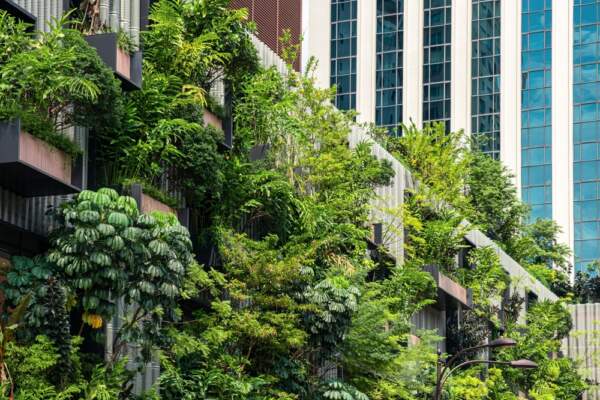Sustainability in Architecture
Sustainability in Architecture
As the world becomes increasingly eco-conscious, sustainability in architecture becomes more and more important. But, what exactly does it mean and entail?
In this article, we explore what sustainable architecture is, the key considerations involved, and the main benefits of this practice.
What Is Sustainable Architecture?

Also referred to as “environmental architecture” or “green architecture”, sustainable architecture is the practice of designing and constructing buildings with the aim of minimising environmental impact whilst concurrently optimising various factors. These include energy efficiency, waste management, water usage, and materials selected.
It strives to reduce carbon footprints while providing resilient and livable spaces for current and future generations. In an increasingly environmentally-conscious world, sustainability in architecture has become essential.
Key Considerations and Benefits of Sustainable Architecture
Let’s explore some of the primary considerations in green architecture.
1. Energy Efficiency
Sustainable architecture aims to be as energy-efficient as possible. This is accomplished in numerous ways, such as by optimising ventilation, daylight, and building positioning to decrease the need for heating, air conditioning, and artificial lighting use. Other strategies include incorporating thermal insulation, LED lighting, and energy-efficient windows (such as triple-glazing) to better regulate heat.
Where feasible, renewable energy sources — such as solar panels on roofs — can also be utilised to generate power, reducing reliance on fossil fuels.
2. Materials
Material selection is another important factor. Here are some material properties that are prioritised in environmental architecture:
- Low-Emitting: This means choosing materials that release little to no harmful substances indoors.
- Local: By sourcing locally, issues associated with transportation, such as energy consumption and carbon emissions, are minimised. Moreover, local materials will generally be suited to the local climate, so there is less need to use energy for cooling, heating, and moisture management.
- Recycled: Using materials made from recycled content helps to mitigate resource depletion.
- Reparable and Durable: By choosing options that can be repaired easily and last a long time, the need for replacements is decreased, and there is also less waste.
Did You Know? 3D printing can be used in sustainable construction. It is environmentally friendly as it only uses the materials and precise quantities needed, resulting in minimal waste, making it an eco-friendlier option compared to traditional construction methods.
Some of the most widely used materials in green architecture include recycled steel, salvaged bricks, reclaimed wood, hempcrete, bamboo, and cork.
3. Landscape
Leading on from material selection, incorporating green infrastructure is also important. This can involve vertical gardens, where building walls are covered in plants, and green roofs, where rooftops are covered in vegetation and soil.
These provide numerous benefits, including improving the environment, thermally insulating the building, providing habitats for wildlife, decreasing the risk of flooding, and absorbing air pollution. Furthermore, it can help increase property value, improve air quality, and enhance mental and physical well-being.
Did You Know? At Architecture:WK, we prioritise sustainability in every project. Explore how we have assisted Heathfield Pavilion in working on proposals for a green-roofed sports pavilion and café.
4. Water Quality
Another priority is water management and quality. There are numerous methods through which sustainable architecture conserves water resources, such as by using low-flow fixtures, rainwater harvesting systems, and greywater recycling — the process of treating wastewater from sources such as sinks, baths, and showers, to be recycled for non-potable uses, such as watering gardens or flushing toilets.
Solar hot water systems can also be installed, using the sun’s energy to heat water in the home.
These strategies contribute to reduced water bills, a smaller water footprint, and decreased environmental impact.
5. Social and Economic Factors
Environmental architecture is just as concerned with social and economic well-being. One way this is addressed is with an accessibly-built environment, in other words, designing buildings that can accommodate diverse people of all abilities over time. This makes the building versatile and, consequently, more sustainable.
Another approach is to locally source materials and employment. By choosing to support local businesses and creating jobs in the building’s construction, the local economy is supported, keeping money within the community where the building is being built.
6. Disassembly
Designing buildings for disassembly is an innovative approach that considers the entire lifespan of a structure. Designing for disassembly means constructing buildings so that materials and components can be taken apart and reused with ease at the end of their lifecycle. This results in conserved material value, minimal waste, and promotes a circular economy.
Discover Architecture:WK for Sustainable Architecture
Sustainability is at the heart of everything we do at Architecture:WK. Composed of a team of Teddington architects, we understand that while the aesthetics of a building are important, functionality, durability, sustainability, energy efficiency, and eco-consciousness are just as vital.
All of our projects incorporate sustainable practices, minimising environmental impact as much as possible. For instance, we consider sustainable construction practices, building longevity and usability, and sourcing suitable products and services. Ultimately, we aim to create long-term, unique buildings that improve the overall quality of life of their users.
Top Tip: Check out our past commercial project for Arthur’s Restaurant in Shepperton, where we helped design an eco-restaurant with a green living roof in a flood-risk zone.
Architecture:WK is a RIBA Chartered architecture company dedicated to delivering sustainability in architecture. Get in touch with our professional and friendly team today to find out more.



